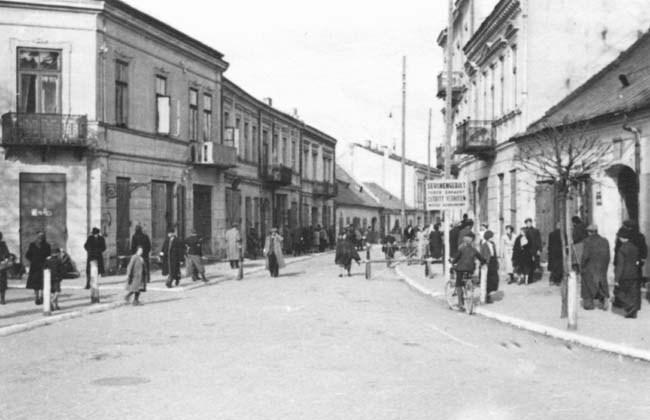
The Holocaust in Poland: Kielce Ghetto (March 1941-August 1942)

Figure 1.--This is a photograph of the entrance to the Jewish ghetto in Kielce. It is undated, but was probanly taken during 1941 before the Ghetto was closed. Notice the Polish/German warning sign, "Seuchengebiet zutritt verbotten / Terem zakaznywsted wzbroweony". Many of the Jews are wearing identifying. We are not sure why all are not wearing the arm bands. Put your cursor on the image to see the arm bands.
|
|
Kielce at the time of World War II was a town in south-central Poland, toiday it is southeast Poland. There were about 24,000 Jews living there, about a third of the population. German armies moving north from occupied Slovakia reached Kielce early in the campaign (September 4). The Germans immediately began taking actions against the Jews, including lootings, shootings, and press gangs. Kieelce became part of the General Government and more organized, legalized suppression of Jews began, including fines, confiscating property, forced labor, and a range of other anti-Semetic actions. The Jews were forced to identify themselves with armbands. A Judenrat was established. The first chairman was Moses Pelc who refused to collaborate adequately with the SS and was as a result deported to Auschwitz. Jews in the town were forced into slave labor at a nearby ammunition plant. Jews from surronding villages were forced into the town. A transport of Vienna Jews arrived (February 1941). Jews in the town were forced to move into a Ghetto (March 31, 1941). This was one of the smaller ghettoes established throughout Poland.
The Germans built a wooden fence and barbed wire barrier to close off the Ghetto. The ghetto had two parts. There was the Big Ghetto made up of several streets: Orla, Piotrkowska, Nowowarszawska, Pocieszki and Radomska. The Small Ghetto -was the triangle formned by St. Wojciech square, Bodzentynska Street and Radomska Street. There were 500 buildings in the ghetto where about 15,000 people loved. That mean about 30 people per building and some of the buildings were small. . The Germans crammed about 27,000 Jews into these buildings as Jews from outside the city were forced into the Ghetto. That meant an average of about about 54 people per building.
The Germans began to liquidate the ghetto as part of Operation Reinhard (August 1942). Most of the Kielce Jews were transported to the Treblinka death camp where they were murdered upon arrival. After 5 days only 2,000 Jews were left in the Ghetto. The survivors were transported to a forced labor camp before also being sent to Treblinka. Hermann Levy who had replaced Moses Pelc was killed by the SS (September 1942).
HBC

Navigate the Boys' Historical Clothing Web Site:
[Return to Main individual Polish ghetto page]
[Return to Main Polish ghetto page]
[Return to Main Polish Holocaust page]
[Return to Main German Blitzkrieg on Poland page]
[Introduction]
[Activities]
[Biographies]
[Chronology]
[Clothing styles]
[Countries]
[Bibliographies]
[Contributions]
[FAQs]
[Glossaries]
[Images]
[Links]
[Registration]
[Tools]
[Boys' Clothing Home]
Created: 5:41 AM 6/8/2010
Last updated: 5:41 AM 6/8/2010



